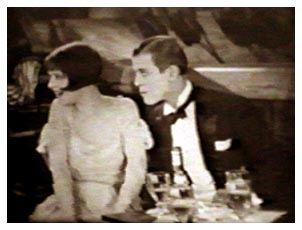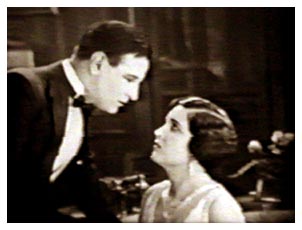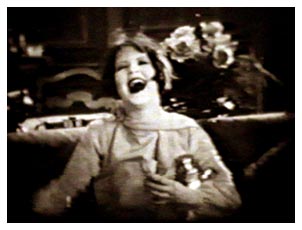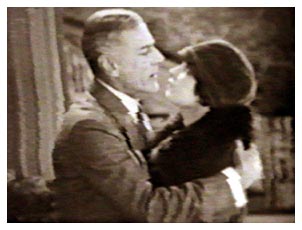

Paramount Pictures
Cast: Alice Joyce (Ethel Westcourt), Clara Bow (Kittens Westcourt),
Norman Trevor (Hugh Westcourt), Conway Tearle (Jerry Naughton),
Dorothy Cumming ("Mazzy" Massarene), Elsie Lawson (Irma),
Donald Keith (Kenneth Cobb)
Ethel Westcourt sits home night after night while her daughter, Kittens, is out with her friends and her husband is out with his girlfriend. At the urging of a friend, Ethel decides it's time that she goes out and enjoys life, too. While out with her friend, she encounters Jerry Naughton, who has a reputation as a womanizer and who has been the object of Kittens' affections. Ethel affects a French accent and gives another name when Jerry shows an interest in her. Ethel's intention in continuing to see Jerry is to protect her daughter from this scoundrel, however, he ends up falling in love with her and she with him. The situation is complicated when Kittens finds her mother at Jerry's apartment. To further complicate matters, Mr. Westcourt arrives on the scene, as well. After Kittens tells her father that she caught Jerry kissing her mother, Westcourt tells Ethel she is now free. Neither the husband nor Kittens knows that nothing had ever happened between the two before, and Ethel had already told Jerry they must never see each other again. When Ethel returns home to get her things before sailing to Europe . . .
For those who want to get the "flavor" of the
Jazz Age in their movies, "Dancing Mothers" is a prime
entreé along with such other delicious choices as "Walking
 Back" (1928) with Sue Carol, "Bare
Knees" (1928) with Virginia Lee Corbin, "The Mad Whirl"
(1924) with May McAvoy, "The Plastic Age" (1925) with
Clara Bow and several others. There's bathtub gin, speakeasies,
flappers, parties, short dresses, and "with-it" adults.
This bohemian lifestyle doesn't come without its price, though,
and that's what makes our story interesting.
Back" (1928) with Sue Carol, "Bare
Knees" (1928) with Virginia Lee Corbin, "The Mad Whirl"
(1924) with May McAvoy, "The Plastic Age" (1925) with
Clara Bow and several others. There's bathtub gin, speakeasies,
flappers, parties, short dresses, and "with-it" adults.
This bohemian lifestyle doesn't come without its price, though,
and that's what makes our story interesting.
In contrast to the typical concept of the stern, authoritarian parental role in pre-World War I homes, "Dancing Mothers" treats us to the modern, 1920's parent who not only approves of his/her child's free-spirited behavior, but participates in the same type of behavior - maybe even with a little more adult twist. Catherine Westcourt (Clara Bow), more commonly referred to as "Kittens," is possibly 18 years old at best, and lives a life of parties, nightclubs, harmless flirtations, and the constant pursuit of having a good time. Although she has a friend, Kenneth (Donald Keith) who dotes on her, she is more interested in Jerry Naughton (Conway Tearle) who is closer to her parents' age and has a reputation for being a "ladies' man," or more bluntly, a "scoundrel."
Early on in the film, a scene in a nightclub establishes the relationship of Kittens to her parents. She is out with Kenneth, and, to his disapproval, dances with Jerry and focuses all of her attention on him. When Kenneth threatens to tell her father of her behavior, she responds, "Go ahead, he's right over there."
Before this line is given in the film, we had already been shown Mr. Westcourt hidden in a corner of the nightclub with a pretty, young girl. The relationship is made clear when he slips money into her purse. Because his back was turned to Kittens, we had assumed she did not know he was there. However, her response to Kenneth not only indicates that she knew of her father's presence at the nightclub, she apparently was indifferent to the fact that he was there with another woman!
The scene shifts to the upscale Westcourt home where the mother, Ethel (Alice Joyce), sits alone night after night. The injustice to the mother is accentuated when, first, she gets a phone call from Kittens, who wants to stay out all night and, therefore, lies saying she is spending the night with a friend - and, secondly, a call from the father saying he must take a last minute business trip to Philadelphia when he is really planning to spend the night with Irma, the younger woman.
This sequence of events sets up the viewer to be in complete sympathy when a friend comes over on one of these lonely nights and convinces Ethel to go the Roof Club with her and a male friend. At first reluctant, Ethel finally exclaims, "I'm going to live!"
With that we cheer for our wronged heroine and even enjoy the fun when she is approached by Jerry Naughton (who does not know she is Kittens' mother). Naughton begins to "come on" to her, so Ethel fakes a French accent and introduces herself as Yvonne de Bresac. Although the behavior of the daughter and the father are disagreeable to us, it is imperative to the viewer's acceptance of Ethel's character that she remain virtuous - and so she does, in spite of this flirtatious ruse. She is not interested in Naughton, but when she learns he is to meet Kittens for lunch the next day, she manipulates a lunch date with him at the same time simply to keep him away from her daughter.
The viewer is compelled to issue another "hooray" for Ethel when the father, who has been tucked away in a corner with his girlfriend all this time, is shocked to see his wife dressed up and at the nightclub. He comes to her table and demands that they go home together. To our delight, Ethel is not intimidated. Instead, she coolly responds that she will be spending the weekend with her friend, Mazzy (Mrs. Masserene). At this point, things become serious, because her husband issues an ultimatum. "Unless you return with me immediately, you needn't return at all." In light of his behavior with the "other woman" up to this point in the story, we are appalled at the hypocritical attitude toward his wife who has certainly done nothing wrong. Given the family dynamics up to this point in the film, we fully expect that she may comply with this demand and are pleasantly surprised when she doesn't. However, director Herbert Brenon doesen't have her answer in the obvious manner. Instead, she ignores the demand and asks Mazzy's escort to dance with her. This provides not only the answer we hoped she would give, but in a way that certainly must "sting" the husband's Victorian attitudes of his wife.
 As noted, Ethel's only interest
in Naughton is to prevent him from seeing Kittens - at least that
is her intention in keeping up the ruse. What she doesn't anticipate
is that he will actually become serious about her, and she, in
turn, falls for him. One of the most memorable intertitles is
given when Ethel initially agrees to meet Jerry for lunch. Mazzy
warns her that she's "playing with fire." Ethel responds,
"I'm playing with life!"
As noted, Ethel's only interest
in Naughton is to prevent him from seeing Kittens - at least that
is her intention in keeping up the ruse. What she doesn't anticipate
is that he will actually become serious about her, and she, in
turn, falls for him. One of the most memorable intertitles is
given when Ethel initially agrees to meet Jerry for lunch. Mazzy
warns her that she's "playing with fire." Ethel responds,
"I'm playing with life!"
The drama reaches its high point one day in Naughton's apartment. The story line neatly and logically arranges all the characters to meet in a major conflagration there. First, Naughton has prodded Ethel until she agrees to come to his apartment alone for dinner. Just prior to leaving, she is agonizing over the decision and whether she should go through with it or not. This "agony" is not due to a lack of trust toward Naughton. Instead it is attributed to the fact that she has fallen for Naughton and does not trust herself. In the meantime, Kittens, who has obviously been drinking, pushes her way past the butler into Naughton's apartment before the master returns home. Meanwhile, Ethel decides she will not go and calls Naughton's apartment to tell him so. However, when Kittens answers, she immediately hangs up - and decides now that she must go. Naughton comes home and tries unsuccessfully to get Kittens to go home. Still unaware that Ethel is Kittens' mother, he doesn't want this young, mildly inebriated, girl there when his "date" arrives. Prior to Ethel's arrival, he succeeds in getting Kittens to go into another room. However, later, Kittens comes out and catches Naughton kissing her mother, the father arrives on the scene, and - to stir in a little seasoning to this boiling pot - a jealous girlfriend of Naughton's is thrown into the mix.
Viewers today must keep in mind that Clara Bow had not attained her superstar status when "Dancing Mothers" was made - but she was on the doorstep. The star of the movie is Alice Joyce, and she does a superb job of playing the faithful wife saddened at the constant absence of her family, the seductive Yvonne de Bresac flirting with a man at a nightclub, and the angst-ridden wife who must maintain her faithfulness and dignity in spite of an unintended love. Reviewer Arthur Lennig said, "(The) mother. . . is a lady, but a lady with the courage of her convictions. She has tolerated her husband's absences for a long time before she ventures out on her own and, even when she does, she is not really intending any affair."1 Variety praised her performance. "Alice Joyce runs away with the film. As the mother she is beautiful and attractively gowned in every scene, while her affair is handled nicely by the director."2 Harrison's Reports was reserved in its comments. "Miss Joyce appears very pretty. . . as the neglected mother, (she) acts well and succeeds in awakening considerable sympathy."3 The New York Times was even less forthcoming with praise. "(Alice Joyce) gives a dignified portrayal, but seems to be too composed in unusually disturbing circumstances."4
Obviously, "Dancing Mothers" is of more interest to us today because of the presence of Clara Bow, and, although she is not the star of this film, it is hard to imagine it being as effective as it is without her energizing performance. She is at once a worldly flapper in an unrestrained adult world, and at the same time an unruly child much in need of guidance and discipline. Through all of this, she exudes her usual sexy appeal - in an innocuous way eons removed from the days of the "vamp."
Lennig observed, "The usual pattern would have Kittens be a charming, sweet, lovable kid with a heart of gold, but she is different. She's brattish, spoiled, inelegant, and a bit boorish. Not knowing how to drink or woo, she does both to excess by getting drunk and by forcing her way into Jerry's apartment. Kittens, however, is by no means villainous, but rather a spoiled, selfish girl - unusual only in that this realistic characterization so seldom appears on the screen."5
Author Jeanine Basinger pointed out, "In 'Dancing Mothers' she's more a willful child just starting out in the world. She takes us to the fast life, staying out late, going to nightclubs, lying to her mother, and flinging herself at an older, experienced man. She's meant to represent a kind of idealized modern girl, a girl who is more independent, more self-reliant, more daring - but who isn't really bad, just full of the devil."6
Assessing her own approach to the character of Kittens,
Bow observed in a contemporary interview, "I saw that the
girl got no sympathy 'cause she played her drinkin'  and
smokin' scenes with a sorta 'This is my business - I gotta right
t'do what I like and I'll do it' air. I played her as a girl
out for havin' fun. When I said mean things, I tired t'put over
the idea with a look after I'd said the thing: 'Oh, why'd I say
that? I didn't really mean it.'"7
and
smokin' scenes with a sorta 'This is my business - I gotta right
t'do what I like and I'll do it' air. I played her as a girl
out for havin' fun. When I said mean things, I tired t'put over
the idea with a look after I'd said the thing: 'Oh, why'd I say
that? I didn't really mean it.'"7
"Dancing Mothers" was a pivotal film in Bow's career. Although she could claim 25 films to her credit up to this point, star status had eluded her. "Dancing Mothers" finally gave her the role that defined the megastar Clara Bow, and the response of the public to her performance made that abundantly clear to Paramount. This was her first film for the company, and they quickly realized what a commodity they had on their hands. She was immediately given a cameo in "Fascinating Youth" (1926), run hurriedly through "The Runaway" (1926) and then given the role that would finally establish her stardom in "Mantrap" (1926) with Ernest Torrence.
"Dancing Mothers" was a hit with audiences on several levels. Certainly, Alice Joyce was a star of sufficient magnitude to attract audiences. To some degree, so was Conway Tearle who competently enacted the role of Jerry Naughton. Tearle had been around almost as long as Joyce (Joyce began her career in 1910, Tearle in 1914) and was a dependable and still popular actor. Bow, obviously, put the film over the top with her performance which fit right in with the risqué tenor of the story. Audiences were delighting in films that filled the screen with a less inhibited, more modern lifestyle than had been portrayed in the first 20 years of the cinema's growth - yet, certain standards had to be maintained, and, certainly, wrongdoing was never to be seen as anything other than calamitous. We see Kittens drinking at such a young age (yes, that's bad, but we are never really given her age). We see Mr. Westcourt in an obvious illicit affair - shocking stuff, but something that was popping up more and more in films - albeit, never with positive results - and the participants are never (well, almost never) in the hero's role.
So far, the conclusion of the film has not been alluded to in this review - mainly because it would be unfair to those who have not seen the film. Suffice it to say that the conclusion marked a departure from the traditional film ending or what one (especially in 1926) would have suspected - which makes it a stronger film and certainly contributed to its success.
"'Dancing Mothers' merits attention as an example of American attitudes towards 'living it up,' night clubs, philandering husbands, and general, though somewhat tame, libertinism," Lennig said. "Although some critics might call it a soap opera (true, there are no profound moments), the film does attempt to deal with real, though somewhat muted, issues. Besides being a sociological document of the Jazz Age, it is also an interesting example of good story-telling."8
 "Beautifully
played," "Not essentially new, " etc.
"Beautifully
played," "Not essentially new, " etc.Variety did not like the ending. "'Dancing Mothers' is a well produced, beautifully played and generally good picture which has one bad feature - and that almost ruinous. It has an anti-climax which makes the concluding episodes seem long and weary." 9
The New York Time said, "'Dancing Mothers,' while not essentially new, is a good story, but in this screen edition it is told in a humdrum fashion with the consequence that one is not perturbed about what happens."10
Herbert Brenon deserves credit for a fine job of balancing a delicate subject that could have become too sappy or too hard-hitting - neither of which is the case here. The storyline flows smoothly, the camera moves about nicely, sets are well-appointed, and the entire look and feel of the film is one of quality.
Of course, Brenon is most remembered for his direction of "Peter Pan" in 1924 with Betty Bronson, but his reputation hangs on more than this one film. Richard Koszarski noted, "Between 1923 and 1928 he was one of the key Paramount directors, and surviving films from this period including the proto-feminist 'Dancing Mothers' (1926), and the James M. Barrie adaptations of 'Peter Pan' (1925) and 'A Kiss for Cinderella' (1926) reveal an exceptionally assured style. He closed out the silent era in top form with 'Beau Geste' (1926) and 'Sorrell and Son' (1927) and was named best director of 1927-28 in a massive Film Daily critics' poll, quite a compliment considering the competition that season."11
Some may regard"Dancing Mothers" as a curiosity piece because it portrays the Jazz Age in much the same fashion that we perceive it from all these years later. But it is much more than that. It is also a solid story about values, family stability, mother-daughter and husband-wife relationships, the menace of excess, and strength of character. It entertains through a variety of emotions, is compact enough to maintain the viewer's interest throughout, and has a strong cast that seem born for the roles which they enact. At this time, "Dancing Mothers" has not been issued on DVD in "restored" form with a specially written score, but it certainly deserves to be.
1 Lennig, Arthur. Classics of the Film. Madison,
Wisconsin Film Society Press, 1965.
2 Variety. February 17, 1926.
3 Harrison's Reports. February 27, 1926.
4 The New York Times. February 16, 1926.
5 Lennig.
6 Basinger, Jeanine. Silent Star.s Alfred A. Knopf, 1999.
7 As quoted in Clara Bow: Runnin' Wild (Doubleday, 1988)
by David Stenn.
8 Lennig.
9 Variety.
10 The New York Times.
11 Koszarski, Richard. An Evening's Entertainment: The
Age of the Silent Feature Picture, 1915-1928. University of
California Press, 1990.
Copyright 2008 by Tim Lussier. All rights reserved.